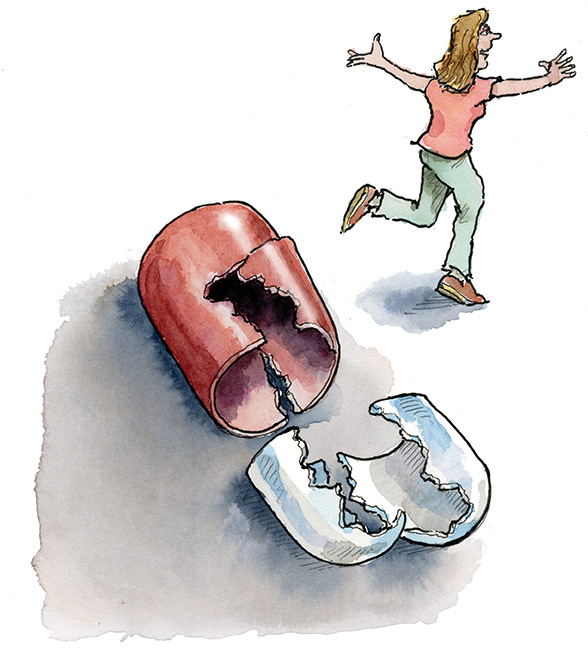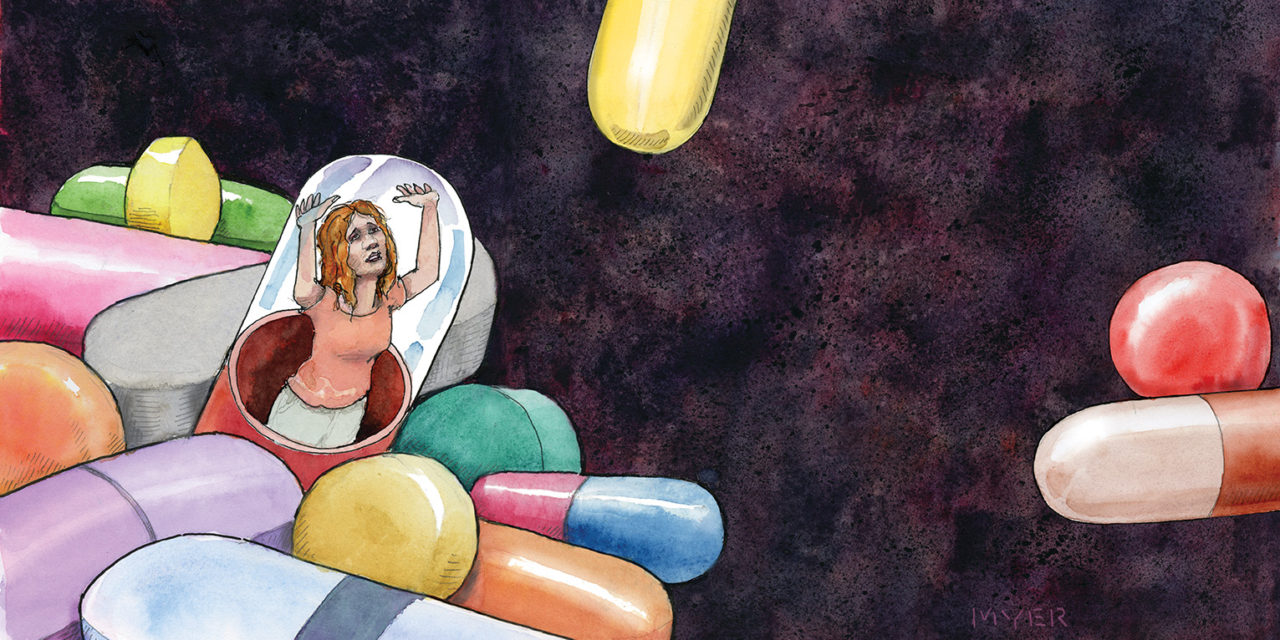As the opioid epidemic reaches a crescendo, women are at particular risk for falling victim to one of the worst public health crises in American history. How did this happen, and what can we do to avoid dangerous and deadly consequences for ourselves and our loved ones? Real Woman investigates.
Susan Morrow distinctly remembers the moment she took her first Fioricet pill. Originally prescribed to help her alleviate chronic migraines, the combination of a barbiturate, acetaminophen, and caffeine did much more than that for Morrow. “I felt so happy and outgoing,” she says. “I was finally able to get out of my own skin.” She frequently suffers from intense migraines as well as anxiety and depression, and the little white Fioricet tablets diminished her pain and insecurities, making her feel normal—or at least what she thought was normal. But along with easing her migraines, these pills also unlocked something deeper inside her.
At the time, Morrow (not her real name) was a NICU nurse at a hospital in Atlantic County, and she relished how the drug kept her anxiety in check, especially during stressful situations. It also opened up her inhibitions to the point that she found herself describing scenes from Fifty Shades of Grey to the father of one of the premature babies in intensive care. Despite these episodes, Morrow couldn’t get enough of the drug. “I loved how the pills helped me not be myself,” she says. “I would take a handful at a time until the prescription was gone. Then I would call in my next prescription right away and go straight through it.” This cycle continued until her doctor caught on and stopped the Fioricet prescription.
Unwilling to come down from this steady high, Morrow asked her primary doctor for a Percocet prescription. While barbiturates like Fioricet are frequently recommended for migraines, opioids like Percocet and Codeine are often substituted to alleviate a patient’s suffering. And once Morrow was on opioids, her troubles really began. “On the days when I ran out of pills, nothing made me happy,” she says. “I would sweat and ache all over, like I had the flu.” When her Percocet prescription finally ran out, she raided the stash of Xanax pills under her parents’ bathroom vanity—anything to avoid going through opioid withdrawal, which made her irritable and restless. Finally, after running through her parents’ pills, Morrow started taking her husband’s Tramadol: “I would just ask the doctor to call in the refills.” For a while, this ensured her a steady supply of opioids.
In 2013, 4 years into her prescription-drug addiction, Morrow became pregnant with her second child. Despite seeing the withdrawal struggles of babies at the hospital who were born physically dependent on opioids (called neonatal abstinence syndrome), she couldn’t bring herself to quit the pills for her unborn child’s health. She desperately needed that feeling of not being herself, and couldn’t get through the day without it. “My husband would sometimes question my behavior, but I was able to get through with lies, and he didn’t push too hard,” she says. Despite spending every waking moment either on prescription pills or hunting down more to stave off withdrawal sickness, Morrow didn’t see herself as a drug addict. “In my mind, an addict was somebody sitting dazed on a side street with a heroin needle sticking out of her arm, and I wasn’t that person; I couldn’t be.”
Thanks to the opioid epidemic sweeping the country, the face of drug addiction is changing, as more and more women like Susan Morrow find themselves hopelessly hooked on prescription pills. Currently in the United States, 31 women lose their lives to opioids every day. While this statistic is staggering, it’s also growing at an alarming rate along with stories of mothers overdosing with toddlers sitting helplessly in the back seats of their cars and twenty-something college students losing their lives to heroin and fentanyl.
The opioid epidemic isn’t a crisis of abuse but one of addiction, and it cuts across class lines. New Jersey’s top four zip codes for opioid overdose include urban areas like Trenton and Camden along with suburban enclaves like Brick and Elizabeth. In Philadelphia alone, about 55,000 people are believed to be abusing opioids, and Philly had 907 drug overdose deaths in 2016. This is an amazing statistic given that all five boroughs of New York City saw a total of 910 overdose deaths that same year. “What this epidemic has shown us is that opioids know no geographic boundary, no demographic or age boundary, and no socioeconomic boundary,” says Deni Carise, PhD, chief scientific officer at King of Prussia–based Recovery Centers of America. “Opioids now effect so many American lives, and we can’t afford to have stigma stopping people from coming into treatment.”
For Susan Morrow, treatment was the farthest thing from her mind, which is why the life of this Jersey girl had to get a lot worse before it got better.
In my mind, an addict was somebody sitting dazed on a side street with a heroin needle sticking out of her arm, and I wasn’t that person; I couldn’t be.
Helping Mothers and Babies at Risk
Capital Health was recently awarded a grant by the state of New Jersey to develop an integrated opioid-treatment program for pregnant women and new mothers. Eric Schwartz, MD, executive director of Capital Health’s Institute for Urban Care, explains the thinking that went into creating For My Baby and Me, a comprehensive, wrap-around treatment program for women in the community.
How did this program come together?
We wove it together with our community partners and by using the grant to fill in the gaps. We partnered with Home Front to give pregnant women or new mothers and their families a place to live while they were getting treatment. Catholic Charities oversees the drug-treatment program, both the medically assisted therapy as well as the intensive outpatient therapy, with help from the Rescue Mission of Trenton and The Trenton Health Team. And Capital Health provides the prenatal care.
How does it work?
When a woman is identified as pregnant or a new mom and needs help around her substance-use disorder, she just calls one number (609-256-7801) and our peer support staff will come meet with her. First thing they do is assess whether she has a safe and sober living situation. If she doesn’t, they can take her to a safe place, make sure she’s up to date with her prenatal care, and enroll her in treatment. In addition to residential housing, we can provide assistance with legal and child care help as well as food, education, and job placement.
We do a lot of intensive outpatient therapy work with patients to deal with the medical withdrawal and help get them through that. Our medication-assisted therapy uses methadone or buprenorphine to fool opioid receptors into thinking that they’re getting the medication they need so a patient doesn’t go through withdrawal. We also coach our patients on what to do when they have urges and how to identify dangerous situations before they happen so that they can take a different path. It also helps to be around other people who are going through similar issues and are working through them.
Why focus on pregnant women?
Being able to treat a mom while she’s pregnant can potentially decrease the withdrawal for the child and decrease their stay in the neonatal intensive care unit and potentially their long-term outcome. We want to avoid any developmental delays for children as well as other medical conditions associated with opioid dependence.
By getting these women into treatment early, we can help them do what’s best for their babies. The program is only funded through June 2018, though, so we’re anxious to get as many women enrolled as possible. Hopefully, our new governor will look at the value that it brings and continues funding it, so we can maintain these services.
Call Them By Their Name
These are the 11 most common opioids listed by ascending order of potency
1. Tramadol
Brand Name : Ultram
2. Meperidine
Brand Name: Demerol
3. Codeine
4. Morphine
5. Hydrocodone
* As potent as morphine
Brand Names: Vicodin, Lortab, Hycodan
6. Oxycodone
Brand Names: Oxycontin, Roxicodone, Percocet
7. Methadone
8. Oxymorphone
Brand Name: Opana
9. Heroin
* 2 to 3 times stronger than morphine
10. Hydromorphone
* 2 to 8 times stronger than morphine
Brand Name: Dilaudid
11. Fentanyl
* 30 to 50 times stronger than morphine
Thrill pills
The term “opioid” refers to drugs derived from the opium poppy plant as well as synthetic derivatives. This includes prescription painkillers like Percocet, Vicodin, and OxyContin as well as heroin, fentanyl, and morphine. These drugs work by sending signals to the brain that block pain and slow breathing to promote a calming and anti-depressive effect. “They allow the synapse areas of your brain to stay flooded with the chemicals that your body itself produces, but that usually stay attached to the receptors for a much shorter period of time,” says Carise. “Knowing who will develop an opioid problem is difficult. I know people who’ve taken them, absolutely hated the feeling, and never took them again. And then there are people who take them for the first time and think, ‘Oh, my god, I’d kill to feel this way every day.’”
While there are plenty of people who take opioids recreationally and get hooked, more and more are becoming addicted after taking pills exactly as prescribed by their doctors. Says Andrew Kolodny, MD, co-director of opioid policy research at Brandeis University, “Regardless of how someone becomes addicted, whether it was from recreational use or because they were prescribed into addiction, once you’re addicted, you aren’t doing this because you’re having fun. Once you’re addicted, you have to keep using opioids to avoid feeling very, very sick.”
When used over time, opioids hijack the body’s natural reward system, causing habitual users to stop enjoying activities like eating and sex. “What quickly happens is that frequent users no longer feel good from using opioids yet they continue using them to ward off the withdrawal symptoms,” says Carise. “People are constantly trying to get back to that first high. They can keep chasing it forever, but they’ll never quite get it back.” This dependency fuels the countless stories of prescription-drug abusers eventually turning to heroin to get their fix. According to the Department of Health and Human Services, 80 percent of heroin users started on prescription opiates. Says Carise, “For the most part, the heroin users we see in treatment say that they transitioned to that drug because prescription opiates were more expensive.” With heroin being cheaper than ever and the increased availability of the powerful synthetic drug fentanyl, New Jersey and Pennsylvania are witnessing staggering rates of opioid abuse and overdose deaths. In 2014, these two states had 6,683 overdose deaths, nearly 15 times their 2004 total of 455.
The tidal wave of prescription opiates flooding pharmacies—260 million opioid prescriptions were given out last year alone—kicked off an epidemic that claimed 42,300 lives in 2016, mostly due to heroin and fentanyl overdoses. And, in recent years, women have started comprising a larger share of these depressing statistics. “Women have been disproportionally impacted by the opioid-addiction epidemic,” says Kolodny. “Between 1999 and 2015, the rate of deaths from prescription opioid overdoses increased 471 percent among women compared to an increase of 218 percent among men.”
One reason women are overdosing on prescription opioids and dying at a higher rate than men is because they’re receiving more prescriptions—30 percent more according to a recent report. “Women are more often healthcare utilizers; they are, for whatever reason, more likely to be diagnosed with chronic pain, and they’re more likely to be prescribed pain relievers at higher doses and for longer periods of time than men,” says Carise. The CDC has found that women become dependent on prescription pain relievers more quickly than men, so when they’re regularly given these pills in large quantities, women often develop significant substance-abuse disorders.
Cut the Pills
The current epidemic is tied to routine overprescription practices decades in the making. “Starting in the late ‘90s, the medical community started prescribing opioids aggressively, and every year since we’ve set a new record for opioid prescriptions in the United States,” says Kolodny. “And as opioid consumption went up, we saw parallel increases in rates of addiction and overdose deaths.” He adds that for years, doctors were overprescribing opioids under the belief that they were safer and less addictive than they actually are. And now, the United States has reached a tipping point. “The overprescribing of these opiates is enough for every man, woman, and child in this country to be medicated around the clock for a month,” says Elaine Pozycki, founder of Prevent Opioid Abuse and co-chair at the Partnership for a Drug-Free New Jersey.
In 2012, Pozycki’s son Steven Michael died of a heroin overdose at the age of 32, after spending the previous 10 years addicted to opioids. In college, Steven was injured while playing lacrosse and, after two shoulder operations, he received a prescription for OxyContin. After his opioid dependence set in and he couldn’t renew his prescription, Steven started buying pills on the street. Soon he turned to heroin. “Our family lived this nightmare for 10 years, and then Steven was perfectly clean when he came out of his last rehab,” says Pozycki. “But one night an old friend came by with some heroin and Steven OD’ed.” She now wishes that she could have done more while her son was battling his addiction. “I didn’t realize he was hooked on those pills,” she says. “I even picked up some of his prescriptions, which is quite upsetting.”
We aren’t used to looking askance at our pharmacies, yet the most commonly prescribed opioids, hydrocodone (Vicodin) and oxycodone (Percocet and Oxycontin), are nearly identical to heroin on the molecular level. “The effects that opioids produce are indistinguishable from the effects produced by heroin, which means that doctors need to be much more careful when prescribing them,” says Kolodny. “If a dentist understood that Vicodin was essentially a heroin pill, would she really give a teenager 30 pills after pulling out his wisdom teeth?”
That’s the thinking behind a law passed last year in New Jersey that Pozycki spearheaded through the state’s assembly. It requires that all patients be informed by a dentist or doctor of the potential addictive qualities of opioids prior to receiving a prescription. The law also requires prescribers to offer a non-opiate alternative, when possible. “Just getting out of the habit of going first to opioids, I think that’s really key,” says Capital Health’s Eric Schwartz. And by mandating a simple conversation about the drug a patient is taking and the reasons they’re taking it, prescribers can put greater control in patients’ hands and provide them with the information they need to look for signs of addiction.
“In an ideal world, you wouldn’t have to pass a law mandating that a prescriber warns a patient that an opioid is addictive,” says Kolodny. He notes that after millions have been invested in misinforming the medical community about the risks and benefits of opioids, many doctors haven’t been weighing the risks versus benefits of these drugs: “They aren’t warning their patients that opioids are addictive because, in many cases, they don’t recognize how addictive they are.”

Getting whole
To Susan Morrow’s immense relief, her son wasn’t born opioid dependent, though the doctors did make note of the chemicals in his system. “They scored him on the Neonatal Abstinence Scoring System, which measures the signs and severity of withdrawal in infants,” Morrow says. “But I was able to explain away the results because I take Paxil, an anti-depression medication that also gives withdrawal-like symptoms.” Denial would continue to play a major role in her life as she brought her newborn home.
Morrow continued using her husband’s Tramadol prescription for another year until she was finally cut off. By then she had run out of options and couldn’t get any more opioid prescriptions. “I was cut off from all the pills and used up all my supplies,” she says. “And I was too much of a wimp to go out onto the streets, and had no idea where to get anything.” So, she turned to alcohol, and that’s where everything went awry.
Morrow drank to avoid going through withdrawal: “At first, a couple shots would do it, but by the end, I was drinking a fifth and a half of vodka a day.” She would routinely pass out on the couch because she liked to drink at home. When it came time to pilot the mom taxi, Morrow would drive her kids around drunk. “On my way to pick up my son from daycare, I would stop at the liquor store, buy some airplane bottles, drink two of them, and go pick him up,” she says. “I assumed nobody could smell the alcohol on my breath even though I had just drank it.”
When her husband found an empty bottle of vodka in the car, he finally threatened to take the kids away. That’s when Morrow decided to get help. She entered an intensive outpatient program that taught her coping skills along with strategies to stay on the road to recovery. Still, it was tough going. “I started working in a pediatrician’s office before entering recovery,” she says. “And each morning, I would go through the DTs, which would cause me to shake the needle as I tried to give children their shots.”
She stuck with it, though, and the shaking settled down. It took Morrow 3 months in the recovery program to finally admit that she was an addict and an alcoholic. “And once I admitted it,” she says, “I was able to accept that I had a problem—that I had this disease that needed to be taken care of.” Since then, she’s focused on staying sober and learning to live with and love herself.
And her husband has remained by her side through it all. “At home, he’s working on the trust. That’s a very hard thing to win back,” she says. “But he’s there for me.” She knows that she faces a neverending battle, as the relapse rates for opioid addiction are high and her alcoholism requires constant vigilance. Recently, when Morrow had surgery on her thumb, she received a Tylenol 3 prescription for the pain. “I took two and then had my husband hide the bottle,” she says. “If I knew where the bottle was, I probably would have taken them.”
On average, a baby is born in withdrawal from opioids every 15 minutes in the U.S.
—According to a new study published in the journal Pediatrics
Warning Signs
Becoming addicted to an opiate is not a conscious decision. Opiates are both physically and psychologically addictive because they stimulate parts of the brain tied with reward. Here are 5 warning signs you can watch for:
- Taking the medication longer than prescribed
- Taking opiates for the euphoric high. Be aware if you begin taking your opiate not to ease pain, but only for the euphoric feeling.
- Improper administration—for instance, grinding and snorting your medication rather than swallowing whole as prescribed.
- Developing a drug tolerance where you need more opioids to achieve the desired effect
- Memory problems






